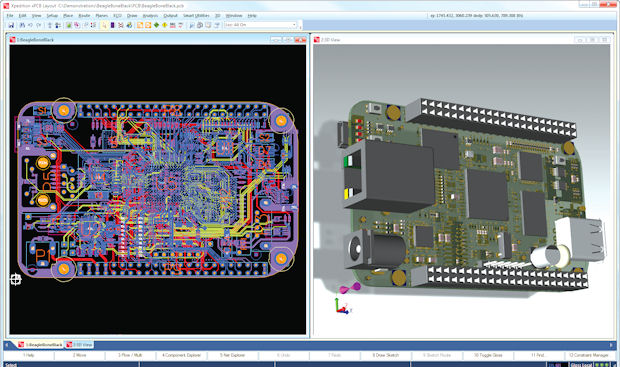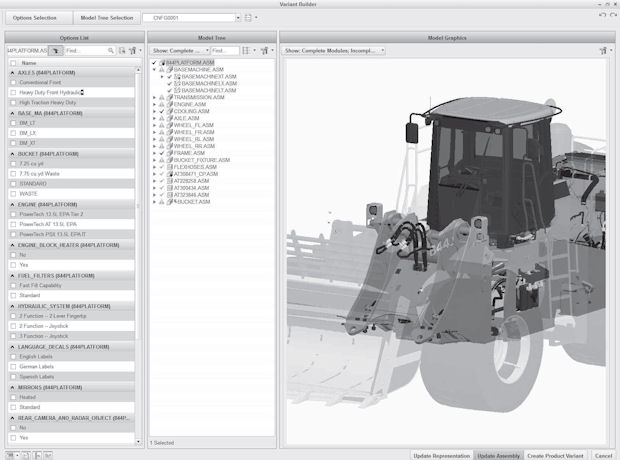
BeagleBone is an example of public-domain, crowd-sourced design reuse. This layout is a version of the BeagleBone Black design created with Mentor Graphics’ Xpedition Enterprise platform.
Latest News
December 1, 2014
 BeagleBone is an example of public-domain, crowd-sourced design reuse. This layout is a version of the BeagleBone Black design created with Mentor Graphics’ Xpedition Enterprise platform.
BeagleBone is an example of public-domain, crowd-sourced design reuse. This layout is a version of the BeagleBone Black design created with Mentor Graphics’ Xpedition Enterprise platform.Design engineers can avoid product design complexity and still meet product feature set requirements while standardizing on fewer product design platforms, creating engineering savings. Case in point, Volkswagen offers 69 different car models from only 16 design platforms. Why do they do it? Because companies that limit the variety of designs, modules and components earn a substantial profitability advantage, much of that due to the engineering savings that a platform approaches make possible.
Platform Approach to Engineering Savings
While using a relatively finite number of product design platforms, companies can produce different products with distinct features. Because this is possible with a limited number of platforms, it is not necessary to endure the engineering expense of creating a new platform altogether each time they undertake a new product design. This can be a considerable savings because new platform design can require two to 10 times the engineering that a product on an existing platform does, says PTC’s James Gehan.
Platform-based design offers the benefits of standardization, which leads to a limited number of solutions to an engineering problem, solutions that are more certain to work due to certainties around compatibility and interoperability. Previously, a designer responsible for brake designs might manage about five different designs for multiple car models, for example. Now, they can develop brakes from two or three different modular designs to suit many different vehicles, says Gehan. “This saves engineering time and effort for the designer,” he says.
Platforms produce engineering savings by changing the fundamental approach to managing product designs. “Before automobile designs were discrete assemblies and the configuration for the brake was inside that,” says Gehan. Modular product designs make it possible for manufacturers to achieve a higher degree of interchangeability of brakes and to insulate changes in one part of the product (the rest of the car in this example) against adversely affecting another part of the product (the brakes).
Because of this insulation, design engineers are free to consider engineering savings that come when other designers use the design variants they create. If the designer is working with variants for a high-end, high-performance vehicle, he may know that the variants are for only this vehicle and will not likely be reused elsewhere. So he can design for best performance with less consideration for reuse.
But if the variants are for a frequently used vehicle design, then the designer must strongly consider reuse, according to Gehan. These considerations can lead to engineering savings for the designer’s colleagues, who may save time and effort by reusing their predecessor’s creations.
 The PTC Creo Options Modeler is a dedicated app for creating and validating 3D modular product assemblies. It is a tool developed to create engineering design savings. Image courtesy of PTC.
The PTC Creo Options Modeler is a dedicated app for creating and validating 3D modular product assemblies. It is a tool developed to create engineering design savings. Image courtesy of PTC.And the engineer who leverages existing, modular designs can complete overall design projects faster and still differentiate a product while using a common platform, says David Wiens, director of business development, System Design Division, Mentor Graphics Corporation. Using design platforms and existing modular designs also keeps design engineers from creating redundant parts that could have quality issues, says Wiens. In the circuit board designs that Wiens is familiar with, reusable designs include data blocks, chipsets and variants.
Platform-based design enables engineers to package, specify and document designs in a way that makes it easier for other project deliverables to arrive more quickly, says Curt Jacobsen, principal, Technology Consulting, PwC. Design reuse becomes more likely when the design engineer has done the packaging, specification and documentation in such a manner as to facilitate reuse. This increases the value in the platform. “When other designers see that value, they start contributing more after the same example and the platform culture comes to life,” Jacobsen says.
The Challenges in Platform-Based Design
Variants are invariably vexing. When designing a variant for a specific new product family, the design engineer must consider the interface that a modular design will connect to, for example, how the interface between the brakes and the rest of the vehicle will look. “With every new interface, there are different variables,” says Gehan.
Reuse is a blessing but can also be a curse. One of the ways that platform-based design challenges the design engineer is that they need to think about the design in terms of how many different ways the vendor and other designers can package and reuse it, says Gehan. “As we get to higher levels of variability on the same platform, the number of ways different designers will use and reuse his designs becomes more diverse,” he says.
The biggest challenge in is the time and effort it takes to properly capture it, document it, archive it on the front end of the project, and otherwise make it easy for others to retrieve and use later. “That process is five to 10 times longer than the creation of the design itself. You have to capture it as a separate block, keep the schematic, the layouts, and the constraints, and make it available for everyone else to use. But even with the challenges, the long-term benefits to doing so are huge,” says Weins.
There are also some organizational challenges. “The architecture of a design reflects the organizational model of the product company,” says Jacobsen. The most natural thing is for design platforms to evolve within certain divisions. It is better for all stakeholders to be involved. Platform-based designs can also take a long time because every stakeholder might want the design engineer to use their ideas.
Overcome Design Challenges
“We approach easing platform-based design [challenges] by using platforms throughout our products so that engineering has a consistent way to understand the platform and to validate and develop to the platform and any design variants,” says Gehan. “Home-grown systems and approaches can’t keep up with newer approaches because they are not modular.” Platforms that make it easy for the designer to investigate the platform while providing multiple ways to package designs rule the day.
For challenges to design reuse, design engineers should have tools that understand and deal with reuse blocks, defining, documenting, and archiving them effectively. “It should be inherent in the toolset to be able to search that set of data after it goes into the library,” says Wiens.
Fitness for reuse lies in design simulation options, which should prove the known good nature of the design using virtual prototyping. Before the prototype is built, these simulations should provide test and validation methods on the desktop computer to prove that the vendor can manufacture the product.
It is the design engineer’s challenge to work against the propensity for designs to represent only certain product company divisions so that designs span product company divisions, giving all stakeholders a voice early on. To further avoid organizational challenges, there should be design governance and open discussion about the design. As to stakeholders having too much voice, the severity of this challenge can depend on the strength of will of the design engineer in making design choices that fall within his purview.
The platform-based approach to engineering design is the way that product vendors have gone or are in the process of going now. The best way to reduce product complexity in a platform-driven environment is to see the platform “glass half full” of design benefits and make ample use of them.
More Info
Subscribe to our FREE magazine, FREE email newsletters or both!
Latest News
About the Author
David Geer is a freelance technology writer based in Northeast Ohio.
Follow DERelated Topics






